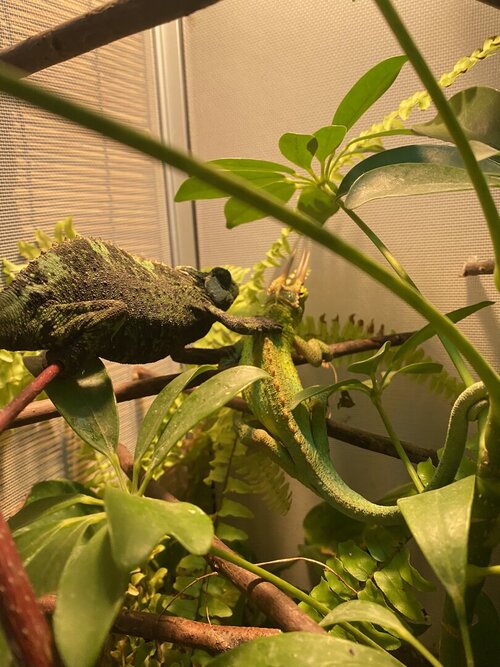Navigation
Install the app
How to install the app on iOS
Follow along with the video below to see how to install our site as a web app on your home screen.
Note: This feature may not be available in some browsers.
More options
You are using an out of date browser. It may not display this or other websites correctly.
You should upgrade or use an alternative browser.
You should upgrade or use an alternative browser.
Have to Jackson mating season ?
- Thread starter Parkjw
- Start date
In captivity there is no specific mating season that i have been able to detect. I don't know why she grabbed him but not receptive females can be aggressive with males. I have never seen it look like that. Hard to tell from one photo.
If she passes ova (slugs) or gives birth she will be receptive a week or two after that. I have read of people letting them see each other from a distance and slowly moving them closer to get the female receptive. It has never worked for me. Dp let us know what works for you.
If she passes ova (slugs) or gives birth she will be receptive a week or two after that. I have read of people letting them see each other from a distance and slowly moving them closer to get the female receptive. It has never worked for me. Dp let us know what works for you.
Klyde O'Scope
Chameleon Enthusiast
Do you know if that still applies to chameleons kept outdoors year-round, where they can experience the change is seasons?In captivity there is no specific mating season that i have been able to detect.
Even if there is no change in seasons, (e.g. kept indoors) don't the typical rituals still apply?
Do you know if that still applies to chameleons kept outdoors year-round, where they can experience the change is seasons?
Even if there is no change in seasons, (e.g. kept indoors) don't the typical rituals still apply?
My outdoor Jackson's do slow down and I have not seen the females pass slugs in the winter. I have not seen any particular time in the warmer months when they are all passing slugs or receptive. My weather doesn't parallel the wet and dry seasons of Kenya at all so I have little reason to think I have the proper trigger. There is likely a combination of factors that may even include barometric pressure. They live close to the equator so length of day may not have as much influence as we might think.
I have noticed that right now ~90% of them are shedding but that's the indoor group. That might have more to do with my feeding routine.
Klyde O'Scope
Chameleon Enthusiast
THX. Sorry if I was unclear; I was asking about mating rituals amongst the indoor denizens. 
I guess I'm unclear on the rituals part of the question. If the female is receptive she will sit quietly while the male does a head bobbing display and approaches her. She may even elevate her tail. If she is un-receptive she will rock back and forth and gape at the male. She may turn dark but sometimes receptive females darken. If he gets too close she may bite him and is capable of causing damage. I never let it go that far.
Klyde O'Scope
Chameleon Enthusiast
This is what I've read (or similar) in a few places.

So do your indoor denizens behave this way or differently? That's what I was wondering.
In looking for the above, I came across this, which kind of cracked me up...
Can't tell if that's the look of a proud parent (doubtful), warning, threat, or what...
Kinda cute though...

Source: https://www.animalspot.net/jacksons-chameleon.html
We know how the rest goes...Jackson's chameleons have a mating ritual that mimics their threat ritual. The male will initiate the threat display to the female which includes color changes, throat inflation and raising the forelegs toward the opponent. The female then has two choices. She can make threatening gestures back, in which case she does not want to mate. If she does want to mate, she will make weak threatening gestures or make no gesture at all in which case the male recognizes her willingness. The male then...
https://animaldiversity.org/accounts/Chamaeleo_jacksonii/
So do your indoor denizens behave this way or differently? That's what I was wondering.
In looking for the above, I came across this, which kind of cracked me up...
Can't tell if that's the look of a proud parent (doubtful), warning, threat, or what...
Kinda cute though...
Source: https://www.animalspot.net/jacksons-chameleon.html
Lindasjackson
Chameleon Enthusiast
Parents will eat their own young. That picture is cute though if you look at it from a proud parent point of view But it looks to me more like he’s hoping it will drop into his mouth!
Klyde O'Scope
Chameleon Enthusiast
Thanks Linda. That was one of the possibilities ("or what...") that occurred to me, but I didn't want to mention it, as I wasn't sure.Parents will eat their own young. That picture is cute though if you look at it from a proud parent point of view But it looks to me more like he’s hoping it will drop into his mouth!
It still strikes me as kinda neat for a Supply the caption/meme contest or something.
jagmom98
Established Member
this is adorable!This is what I've read (or similar) in a few places.
We know how the rest goes...
So do your indoor denizens behave this way or differently? That's what I was wondering.
In looking for the above, I came across this, which kind of cracked me up...
Can't tell if that's the look of a proud parent (doubtful), warning, threat, or what...
Kinda cute though...
View attachment 321607
Source: https://www.animalspot.net/jacksons-chameleon.html
Similar threads
- Replies
- 3
- Views
- 262
- Replies
- 0
- Views
- 452
- Replies
- 7
- Views
- 1K






